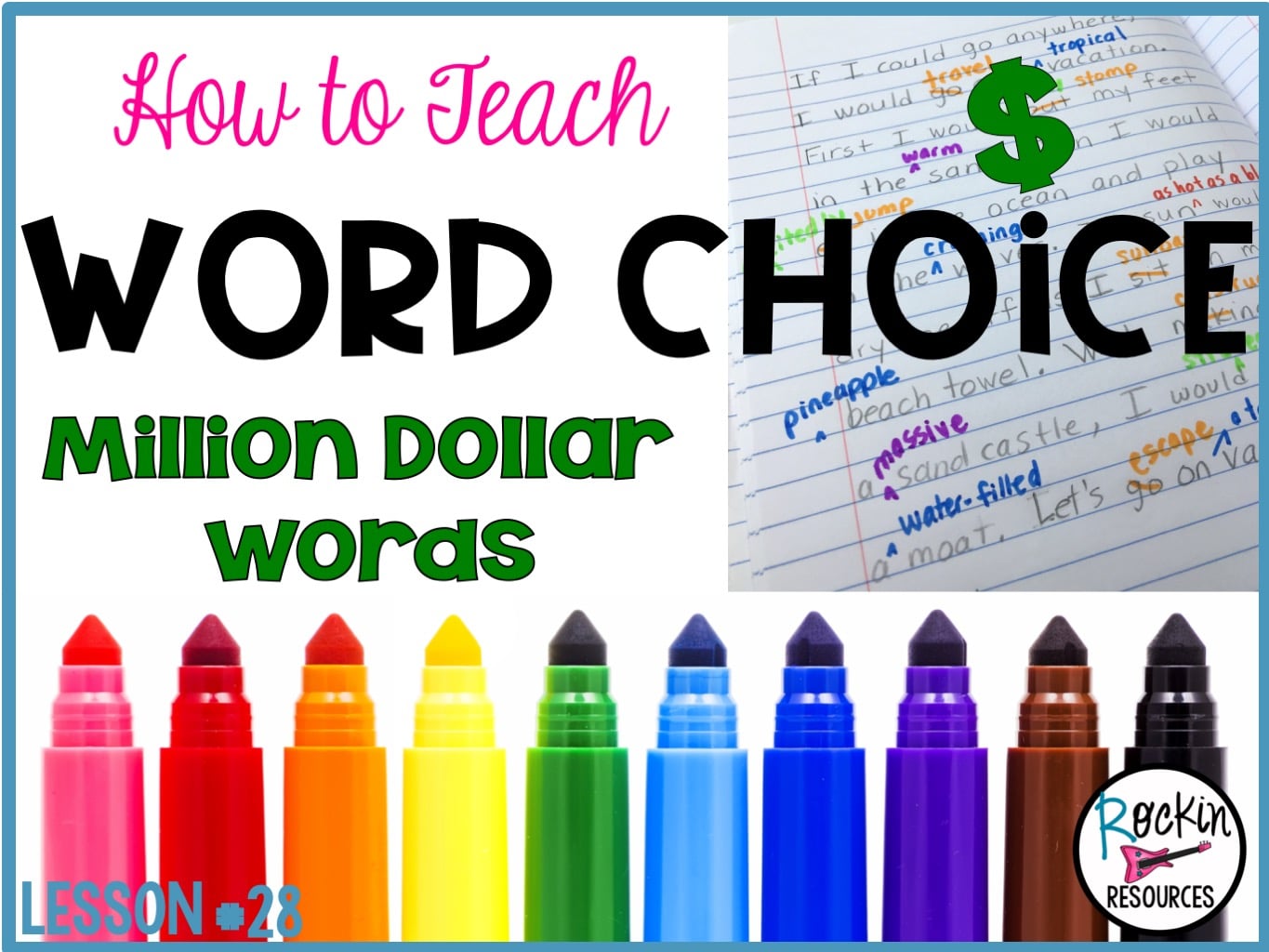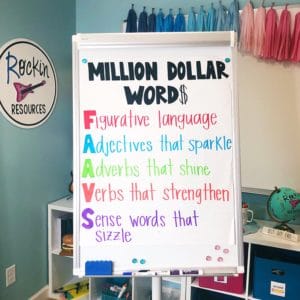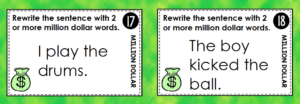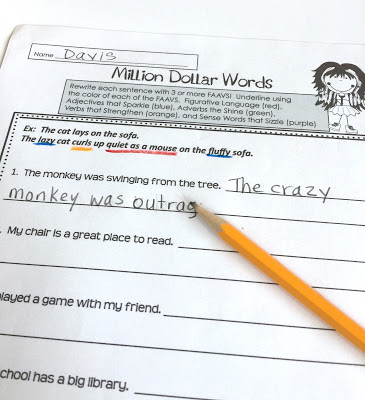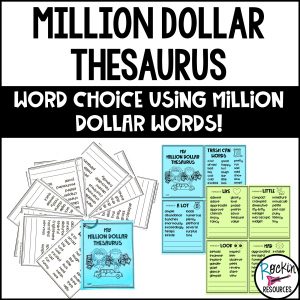Do your students struggle using strong word choice in their writing? This post is geared towards the upper elementary or middle school and uses the term MILLION DOLLAR WORDS when referring to word choice. It is part of the revising stage of the writing process. This post is part of a series of writing mini-lessons designed for scaffolding in writing workshop!
Using good WORD CHOICE will make students’ stories more creative, descriptive and create an image in the reader’s mind. Follow these steps to find ways to teach students how to exchange boring words for MILLION DOLLAR WORDS.
1. TEACH
First you need to teach students about Million Dollar Words. I like to use anchor charts to teach the lesson. Anchor charts can be handmade, printed from a resource, placed on a smart board, used as a screenshot on your computer during distance learning. I also like to create space in my classroom to hang the anchor charts for reference during the lesson. This can be a bulletin board or writing center. With the FAAVS, point out that each letter represents a type of million dollar word. You can also point out that each letters has a color to represent it. This is helpful for students to color-code their sentences. Also explain that many of the sense words can also be adjectives. They were added as a separate category to give students every possible way to think of ways to add million dollar words to their sentences!
Explain and give examples of each of the FAAVS
2. MENTOR TEXT
I am a big fan of mentor text when teaching different writing skills. It is important to show students how real authors use that skill. In all of the STEP-BY-STEP INTERACTIVE WRITING NOTEBOOKS, I include mentor text suggestions. I also give examples and modeling to help you and your students better understand WORD CHOICE and SEE it in well-crafted text. (I use affiliates solely to keep my blog running so I can provide quality content and ideas for teacher.)
Brave as a Mountain Lion by Ann Herbert Scott
Owl Moon by Jane Yolen
Quick as a Cricket by Audrey Wood
The Whales by Cynthia Rylant
The Z Was Zapped by Chris Van Allsburg
The Boy Who Loved Words by Roni Schotter
Under the Quilt of Night by Deborah Hopkinson
When Marian Sang by Pam Munoz Ryan
Noah Webster and His Words by Jeri Chase Ferris
Caves by Stephen Cramer
If Not for the Cat by Mary Blount Christian
Roxaboxen by Barbara Cooney
The Bunyans by Audrey Wood
Monkey Business by Wallace Edwards
CLICK HERE FOR A POST ABOUT MENTOR TEXT FOR MILLION DOLLAR WORDS
How do you use mentor text?
Go through the book and pick out places where the author shows good imagery. As you read the book to the students, stop and point out the words you marked. Here is an example form I Love You the Purplest by Barbara M. Joossee. Say to the students, “Close your eyes and make a picture in your mind as I read a few sentences.”
“The lake slowed its thrashing to a soft, even beat. The mosquitos dipped low to the water and the water bugs skittered on top. The moon glowed on one side of the lake while the sun shimmered on the other.”
3. MODEL
Give examples of each one of the FAAVS using the same sentence to show how to BUILD A SENTENCE.
Also model using FAAVS in a class story as part of the revising step.
4. TAKE NOTES
Students should take notes to help retain the information and gain ownership of their writing. Here is an example using interactive writing notebooks.
5. STUDENT RESOURCES
Provide students with copies or example of FAAVS to keep in their writing folder as a reference when writing independently in the future. You can also use a thesaurus, a Million Dollar Dictionary with lines to add more or even a mini-thesaurus of their own like shown below.
6. PRACTICE
When students practice during center time or groups, task cards are a lifesaver! I like to scaffold the cards for practice. First, students choose the best million dollar word to use in a sentence. Then, students rewrite basic sentences with million dollar words.
Another idea is identifying the different types of FAAVS using color. With the different colors assigned to each FAAVS, students can color in areas or underline with that particular color to show they understand the differences between the letters in FAAVS!
7. APPLY
Students should then take their rough draft and REVISE by exchanging boring words with million dollar words. If students use one color or even the different colors mentioned above, you will be able to see how many times they were able to revise!
8. SHARE
When students share their work, it provides them with a deeper understanding! They gain knowledge from each other so share share share!
DO YOU NEED A BULLETIN BOARD IDEA?
Write a million dollar sentence, color-code, and illustrate. I like to walk around the room while students are adding million dollar words to their narrative stories. When I find someone who created a great example, give him/her something to write on and place it on a MILLION DOLLAR BULLETIN BOARD. Students get so excited to see classmates doing this and start busily doing the same! It makes an adorable bulletin board. I actually kept mine up all year and referred back to it and shared examples from it when we were revising different essays. Here are some examples:
When your students are finished with this lesson, you will see their writing transform into a beautiful descriptive story!
Check out my FREE writing masterclass! CLICK HERE
LAST LESSON:WRITING MINI LESSON #27- ROCKIN BEGINNINGS
NEXT LESSON: WRITING MINI LESSON #29- VARIETY OF SENTENCES!
CLICK HERE FOR THE FULL LIST OF WRITING MINI LESSONS
This lesson can be found:
Grab this Million Dollar Mini Thesaurus to go along with the lesson!
This lesson is also included in the STEP-BY-STEP WRITING® Program with mini-lessons designed to scaffold through the writing process. Writing units included are sentence structure, paragraph writing, narrative writing, opinion writing, and informative writing. See what is included in the image below and click on it to learn more about them! You will turn your reluctant writers into ROCKSTAR WRITERS™!
“I can’t say enough about how great this resource is. We’ve finished the first unit, and I followed each lesson as written out! The grade three and four aligned, but had different lessons, so I looked like a superstar teacher in the first paragraph writing month. Best thing bought from TpT! Would recommend wholeheartedly from a veteran 22 year teacher!” – Diana

